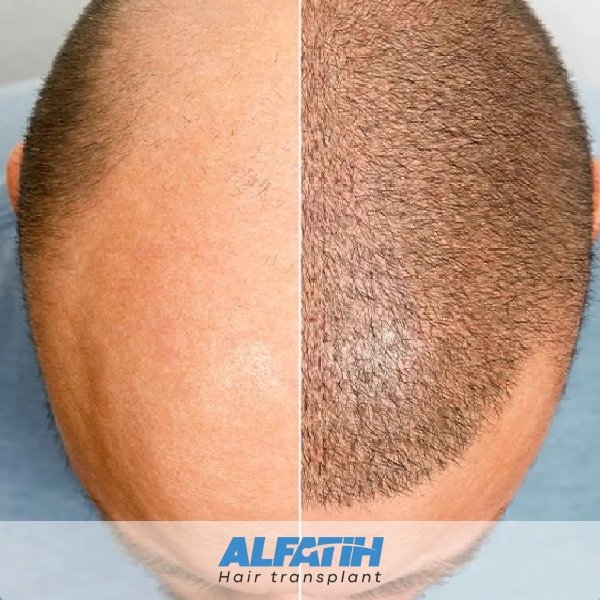The recovery period after a hair transplant can vary depending on the type of procedure, the individual’s health, and how well they follow post-operative care instructions. Here’s an overview of what to expect during the recovery period:
Immediate Post-Operative Period (First Few Days)
- First Day:
- Rest: Patients are usually advised to rest and avoid strenuous activities.
- Head Position: Keeping the head elevated can help reduce swelling.
- First 2-3 Days:
- Swelling and Discomfort: Mild swelling and discomfort around the forehead and scalp are common. Pain medication prescribed by the surgeon can help.
- Bandages: If bandages were used, they are typically removed within the first 1-2 days.
- Scab Formation: Tiny scabs may form around the transplanted hair follicles. It’s important not to pick at these scabs.
Early Recovery (First Week)
- Washing Hair:
- Gentle Washing: Patients are usually instructed to start gently washing their hair around 3-4 days after the procedure. A mild shampoo and careful handling are recommended to avoid disturbing the grafts.
- Avoiding Physical Strain: Activities that might cause sweating or increase blood pressure should be avoided.
Week 2 to Week 4
- Scabs and Redness:
- Scabs Falling Off: By the end of the second week, most of the scabs should have fallen off.
- Redness and Itching: The recipient area might still be slightly red and itchy.
- Shedding of Transplanted Hair:
- Shock Loss: It’s normal for the transplanted hair to fall out 2-3 weeks post-surgery. This is a temporary phase before new growth begins.
Intermediate Recovery (1-3 Months)
- Hair Growth Cycle:
- New Growth: New hair starts to grow from the transplanted follicles around 3-4 months post-surgery.
- Follow-Up Visits: Regular check-ups with the surgeon to monitor progress and address any concerns.
Long-Term Recovery (6-12 Months)
- Full Growth:
- Hair Density: Significant hair growth and density can be observed between 6-12 months post-transplant.
- Mature Hair: By the end of one year, the transplanted hair should have matured and achieved a natural look.
General Care Tips During Recovery
- Avoid Direct Sunlight: Protect the scalp from direct sunlight for the first few months.
- Healthy Diet: Maintaining a balanced diet rich in vitamins and minerals can support hair growth.
- Avoid Smoking and Alcohol: Refrain from smoking and consuming alcohol as they can impede the healing process.
Possible Complications and When to Seek Help
- Infection: Uncommon but possible. Signs include excessive redness, swelling, pain, and discharge. Seek medical attention if these symptoms occur.
- Persistent Pain or Swelling: If pain or swelling persists beyond the first few days, consult the surgeon.
Conclusion
The recovery period after a hair transplant involves several stages, from immediate post-operative care to long-term monitoring of hair growth. Adhering to the surgeon’s post-operative instructions and attending follow-up appointments are crucial for optimal results. By the end of one year, most patients can expect to see significant improvements in hair density and appearance.
The recovery period after a hair transplant can vary depending on the type of procedure, the individual’s health, and how well they follow post-operative care instructions. Here’s an overview of what to expect during the recovery period:
Immediate Post-Operative Period (First Few Days)
- First Day:
- Rest: Patients are usually advised to rest and avoid strenuous activities.
- Head Position: Keeping the head elevated can help reduce swelling.
- First 2-3 Days:
- Swelling and Discomfort: Mild swelling and discomfort around the forehead and scalp are common. Pain medication prescribed by the surgeon can help.
- Bandages: If bandages were used, they are typically removed within the first 1-2 days.
- Scab Formation: Tiny scabs may form around the transplanted hair follicles. It’s important not to pick at these scabs.
Early Recovery (First Week)
- Washing Hair:
- Gentle Washing: Patients are usually instructed to start gently washing their hair around 3-4 days after the procedure. A mild shampoo and careful handling are recommended to avoid disturbing the grafts.
- Avoiding Physical Strain: Activities that might cause sweating or increase blood pressure should be avoided.
Week 2 to Week 4
- Scabs and Redness:
- Scabs Falling Off: By the end of the second week, most of the scabs should have fallen off.
- Redness and Itching: The recipient area might still be slightly red and itchy.
- Shedding of Transplanted Hair:
- Shock Loss: It’s normal for the transplanted hair to fall out 2-3 weeks post-surgery. This is a temporary phase before new growth begins.
Intermediate Recovery (1-3 Months)
- Hair Growth Cycle:
- New Growth: New hair starts to grow from the transplanted follicles around 3-4 months post-surgery.
- Follow-Up Visits: Regular check-ups with the surgeon to monitor progress and address any concerns.
Long-Term Recovery (6-12 Months)
- Full Growth:
- Hair Density: Significant hair growth and density can be observed between 6-12 months post-transplant.
- Mature Hair: By the end of one year, the transplanted hair should have matured and achieved a natural look.
General Care Tips During Recovery
- Avoid Direct Sunlight: Protect the scalp from direct sunlight for the first few months.
- Healthy Diet: Maintaining a balanced diet rich in vitamins and minerals can support hair growth.
- Avoid Smoking and Alcohol: Refrain from smoking and consuming alcohol as they can impede the healing process.
Possible Complications and When to Seek Help
- Infection: Uncommon but possible. Signs include excessive redness, swelling, pain, and discharge. Seek medical attention if these symptoms occur.
- Persistent Pain or Swelling: If pain or swelling persists beyond the first few days, consult the surgeon.

Conclusion
The recovery period after a hair transplant involves several stages, from immediate post-operative care to long-term monitoring of hair growth. Adhering to the surgeon’s post-operative instructions and attending follow-up appointments are crucial for optimal results. By the end of one year, most patients can expect to see significant improvements in hair density and appearance.


